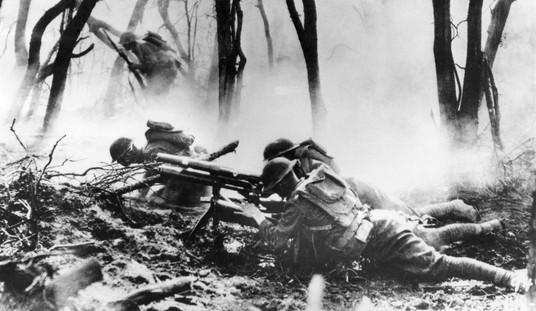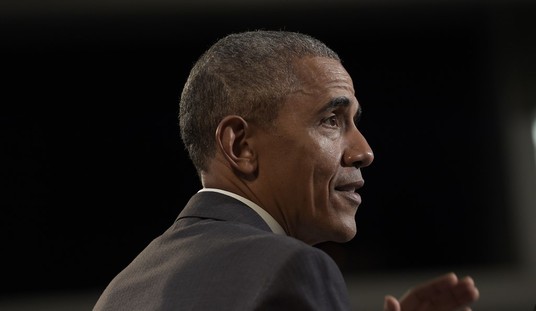Why is mercy less potent than cruelty?
Newsweek calls Kim Jong Un “the last Bond bad guy”, in reference to his almost cinematic villainy. The North Korean dictator’s latest project is apparently to persecute Christians, in addition to his practice of executing high officials by anti-aircraft machine gun fire, mortar and flamethrower. These accounts are apparently true. His latest stunt, which involves machine-gunning a line of hapless victims with six 14.5mm ZPU-4 AAA guns is supported by overhead reconnaissance evidence.
Sometime on or about October 7th, 2014, some very unusual activity was noted on satellite imagery of the Kanggon small arms firing range. Instead of troops occupying the firing positions on the range there was a battery of six ZPU-4 anti-aircraft guns lined up between the firing positions and the range control/viewing gallery. The ZPU-4 is an anti-aircraft gun system consisting of four 14.5mm heavy machine guns (similar to a U.S. .50 caliber heavy machine gun) mounted on a towed wheeled chassis. It is neither safe nor practical to use such weapons on a small arms range, as the combined weight of fire from the six ZPU-4 (a total of 24 heavy machine guns) would quickly destroy the downrange backstop and necessitate reconstruction. A few meters behind the ZPU-4s there appears to be either a line of troops or equipment, while farther back are five trucks (of various sizes), one large trailer, and one bus. This suggests that senior officers or VIPs may have come to observe whatever activity was taking place. Most unusual in the image, perhaps, is what appears to be some sort of targets located only 30 meters downrange of the ZPU-4s.
The most significant element of Kim’s tableau are the viewing stands. The proceedings were meant to be watched by those it was intended to terrify. The purpose of these grotesque spectacles is simple: pour encourager les autres: to impress the audience with the power of the North Korean king and to strike fear into the hearts of anyone who should think of crossing him.
Kim isn’t the only candidate for the James Bond bad-guy sweepstakes. The New York Daily News notes that in Syria, both Assad and ISIS vie to outdo each other in cruelty by performing a series of acts each more dreadful than the last. “Assad’s forces “continued to perpetrate massacres” and commit rape, torture and kidnappings, while ISIS chops off body parts of total innocents in Syria.” These horrible spectacles are in their own perverse way a form of statecraft, as dueling potentates compete for the crown of the Most Terrible.
To the Most Terrible goes the allegiance of the crowd. ISIS knows this, according to some analysts, and is therefore pursuing “strategy of social control … designed to frighten an audience into submission”. Just how well it works is demonstrated by the reluctance of Western intellectuals to say anything that might provoke or anger Islamic radicals even to the point of not drawing cartoons. While they explain their delicacy away as the consequence of high-minded enlightenment, were they more candid they would admit the real reason was fear. The more frightful ISIS is, the more “tolerant” Western intellectuals become.
Historically the West was not above using the tactics of fright. In the aftermath of the Indian Mutiny, for example, when the British were struggling to reimpose their authority upon the subcontinent, they found it expedient to punish some of the mutineers by the method of “blowing from a gun”.
Blowing from a gun is a method of execution in which the victim is typically tied to the mouth of a cannon and the cannon is fired. George Carter Stent describes the process as follows:
“The prisoner is generally tied to a gun with the upper part of the small of his back resting against the muzzle. When the gun is fired, his head is seen to go straight up into the air some forty or fifty feet; the arms fly off right and left, high up in the air, and fall at, perhaps, a hundred yards distance; the legs drop to the ground beneath the muzzle of the gun; and the body is literally blown away altogether, not a vestige being seen.”
Blowing from a gun is every bit as effective as being riddled by a battery of ZPU-4s, and judging from the fact that India remained British until 1947, quite persuasive. In fairness to the British, the practice of “blowing from a gun” was established local practice. The Mughals had invented it before them.
Blowing from a gun was a reported means of execution as long ago as the 16th century, by the Mughal Empire, and was used until the 20th century. The method was utilized by Portuguese colonialists in the 16th and 17th centuries, from as early as 1509 across their empire from Ceylon (modern day Sri Lanka) to Mozambique to Brazil. The Mughals used the method throughout the 17th century and into the 18th, particularly against rebels.
Arguably, the nation most well known to have implemented this type of execution was the British Empire, in its role as paramount power in India, and in particular as a punishment for native soldiers found guilty of mutiny or desertion. Using the methods previously practised by the Mughals, the British began implementing blowing from guns in the latter half of the 18th century, with the most intense period of use being during 1857 sepoy mutiny, when both the British and the rebelling sepoys used it frequently.
The practice is said to have been still in use in Afghanistan in 1930.
These acts of spectacular cruelty are an indictment of humanity, though not in the way one might think. Their frequency in history as an instrument of statecraft is a testament to the susceptibility of human nature to what Niccolo Machiavelli recommended: “it is better to be feared than loved, if you cannot be both.”
The effectiveness of brutality contrasts sharply with the disappointing returns on mercy. Kindness apparently gets you nowhere. Many of the current ISIS, al-Qaeda or Taliban war criminals are individuals who were released from US prisons when America showed them mercy. Perhaps nothing illustrates the failure of kindness than Camp Bucca.
After the Abu Ghraib prisoner abuse scandal, many detainees from Abu Ghraib were transferred to Camp Bucca. After a substantial turn-over in the chain of command at Camp Bucca and substantial amendments to camp policy, the US military held up Camp Bucca as an example of how a model detention facility should be run. A majority of the detainees were reportedly housed in cinder block housing units with wooden roofing rather than tents, while other detainees were held in hasty tent compounds until 2009. Detainees organized and administered their own classes in subjects like literacy and religion, and competed in soccer matches. Cigarettes, tea, and the opportunity to listen to radio and T.V. programs were used as incentives for good behavior. Some detainees were allowed family visitation from Iraqi relatives not held at the facility.
Additionally, the internment facility had its own U.S. Army run hospital to serve detainees. It offered comprehensive healthcare. There was an emergency room, internal medicine clinic, optometry clinic, psychiatric services, orthopedic/surgical unit, physical therapy clinic, pharmacy, dental clinic, dietary services and more. Detainees were screened by medics and doctors at the wire, that was right out where the detainees are housed, and then triaged to the hospital for further care. Some detainees were flown to larger medical facilities in Iraq to receive cataract surgery. U.S. Army medical staff was also given training on how to provide care while respecting Muslim traditions.
Ninety percent of Camp Bucca’s inmates returned to fighting after they were released. Much of what became ISIS is believed to have been conceived in the camp of American mercy. Was Machiavelli right about people being more motivated by fear than by high purpose? Maybe. And if so, it’s a sad world.
[jwplayer player=”1″ mediaid=”43211″]
Recently purchased by readers:
Washington’s Spies, The Story of America’s First Spy Ring
Hal Moore: A Soldier Once . . . And Always [Kindle Edition]
Bloodlands, Europe Between Hitler and Stalin
The Bad War, The Truth NEVER Taught About World War II
The Next Decade, Where We’ve Been . . . and Where We’re Going by George Friedman
The Polish Officer, A Novel by Alan Furst
Vestiges of Grandeur, Plantations of Louisiana’s River Road
Possibly worth buying:
Charlie’s Place, The Saga of an American Frontier Homestead [Kindle Edition]
Stonewalled, My Fight for Truth Against the Forces of Obstruction, Intimidation, and Harassment in Obama’s Washington, Sharyl Attkisson
America’s Secret War, Inside the Hidden Worldwide Struggle Between America and Its Enemies
Assault and Flattery, The Truth About the Left and Their War on Women
Did you know that you can purchase some of these books and pamphlets by Richard Fernandez and share them with you friends? They will receive a link in their email and it will automatically give them access to a Kindle reader on their smartphone, computer or even as a web-readable document.
The War of the Words for $3.99, Understanding the crisis of the early 21st century in terms of information corruption in the financial, security and political spheres
Rebranding Christianity for $3.99, or why the truth shall make you free
The Three Conjectures at Amazon Kindle for $1.99, reflections on terrorism and the nuclear age
Storming the Castle at Amazon Kindle for $3.99, why government should get small
No Way In at Amazon Kindle $8.95, print $9.99. Fiction. A flight into peril, flashbacks to underground action.
Storm Over the South China Sea $0.99, how China is restarting history in the Pacific
Tip Jar or Subscribe or Unsubscribe to the Belmont Club










Join the conversation as a VIP Member